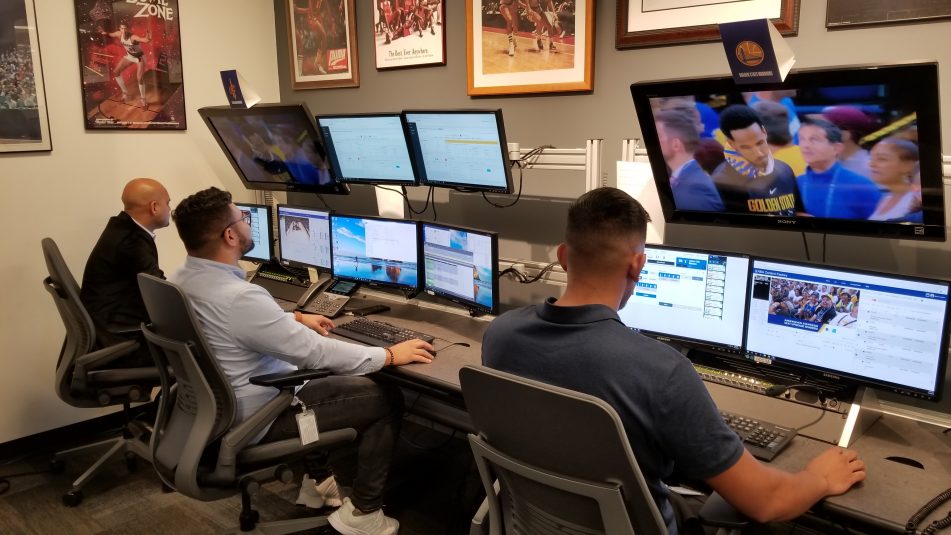NBA Takes Steps To Bring New Accuracy, Timeliness to Statistics
A courtside team is integrated with an operation at league headquarters
Story Highlights
Four years in the making, the NBA’s recently completed project is intended to bring a new level of accuracy and timeliness to statistics, a move that will please everyone from fans to fantasy sports players to rightsholders and even to players and their agents.

A Game Operations Center at the NBA facility in Secaucus, NJ, allows teams to work hand-in-hand with the caller teams at the arenas.
“For the first time, we have a networked statistical system with central oversight in order to maintain absolute accuracy and be able to correct things the same night as the game,” says Steve Hellmuth, EVP, media operations and technology, NBA Entertainment.
The improved Next Generation Stats System replaces an 18-year-old system that worked fine, according to Chris Halton, VP, media technology and operations, NBA, but was technically limited for keeping up with the demands of fans and rightsholders.
“We wanted to increase the speed of data collection,” he explains. “A lot of that has to do with how we modernized the interface for data collection courtside. Once we receive the data, we can transfer it back using messaging-layer technology similarly used in Wall Street trading platforms.”
The system brings together next-generation video tools that give not only statisticians located courtside but staffers in the NBA Game Operations Center in Secaucus, NJ, access to multi-angle video content to review plays and contribute to immediate verification of statistical events. And it’s used not only for NBA games but also for the WNBA, the G League, and even the Junior League and Summer League.
One of the weaknesses of the previous system was that a number of data fields needed to be filled out for each play during the game and every field needed to be filled out before the statistician would hit submit and publish the data. The new system allows data for each field to be published independently so that critical data, like scoring information, can be sent out as quickly as possible.
“It’s incredibly quick and gets information on the messaging framework so it is available to in-arena servers, scoreboards, videoboards, and then rebroadcast to the NBA in Secaucus, where it is tied to a whole new suite of APIs,” says Halton. “The combination of stats and video dramatically improves the speed, quality, and delivery of our statistics to fans and partners around the world.”
The Courtside Team
Inputting the data at courtside are a primary, a secondary, and two callers. The primary enters information like who made the play, highly valuable information because it changes the score. The secondary finishes the metadata with such data as whether a shot was an alley-oop, or can fix something, such as changing a three-pointer to a two-pointer.
“We wanted a different approach to data entry,” notes Halton. “We came up with a radically new idea that didn’t require one person to log information into the interface and a caller to watch the game and tell them what to enter. That created a natural delay.”
The tertiary inputter is trained to flag plays that might need to be reviewed and discussed during a break.
“They take notes and create a laundry list of things to be reviewed,” says Halton.
Courtside personnel can use either a touchscreen stylus or a mouse to enter information related to on-court action.
Integration With Secaucus
The changes courtside have been integrated with the development of a Game Operations Center at the NBA facility. It has dedicated pods for up to 14 concurrent games with a statistics auditor and a help-desk technician who watch each game, have access to up to nine video sources, and can even watch the courtside stats team. The two teams are in constant communication during the game and can work together to add additional data to plays, correct statistics, and more.
“Previously, stats would be fixed later, but now we can fix them on the fly,” Hellmuth notes. “When the game is put to bed at night, it’s done.”
The stats auditor has an interface that includes a running log of plays as they are called at the arena as well as a graphical representation of the full court. The auditor can click on the spot on the representation indicating where a shot was taken to immediately log the location and whether the shot was successful.
“Shot location is very important,” says Hellmuth. “A lot of data relies on it, and the teams rely on it for accuracy.”
The team in Secaucus also has new technical monitoring tools providing visibility into the arena’s IP infrastructure, servers, and connectivity. If there are any issues, they can be immediately addressed.
It’s all part of an effort to have statistical teams who can keep up with the constant flow of on-the-court action.
“The game moves so quickly that it is hard to stop [and fix something],” says Halton, “but now there is another person so that there is no waiting until the end of the game or the next day.”
